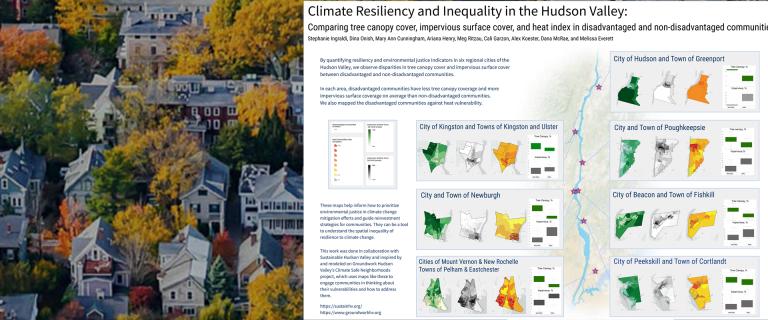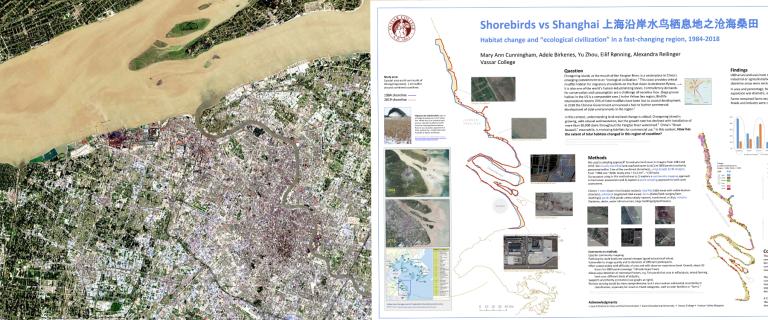Research Opportunities
There are multiple ways that students can participate in field, lab, and archive based research in Earth Science and Geography. We support semester-long independent studies (ESCI/GEOG-198 or -298), research assistantships, senior theses, and summer URSI projects. In these settings, students can work with faculty on existing research projects or together design an original research project that addresses the student′s interests and goals. Faculty also supervise research-based intensives, such as Paleoclimatology, which includes both field and lab experiences.
Examples of Recent and Ongoing Student Research Areas
-
Climate change impacts in West Africa, in the US Corn Belt, and on urban heat islands: in the Hudson Valley and in Poughkeepsie (Cunningham)
-
Greenhouse gas inventories (community and municipal), regional environmental mapping on materials management, food security, and renewable energy; land use change: Cunningham
-
Urbanization, migration, and planning in the Amazon Basin (Godfrey)
-
Public space and social interaction in Rio de Janeiro (Godfrey)
-
Theoretical and empirical studies of gentrification in U.S. cities (Godfrey)
-
Carbon Cycling & Climate during Past Warm Periods (Haynes)
-
Foraminifera as Environmental Indicators in the Hudson River (Haynes)
-
Climate History of the Rensselaer Plateau (Menking)
-
Paleoecology of Zipfeldberg Bog, Dutchess County, NY (Menking)
-
A People’s Geography of the Hudson Valley: This online guide, with entries written by students, explores sites across time throughout the Hudson Valley, centering on social and environmental justice (Nevins)
-
Microplastics in Beach Sediments of Cape Cod (Schneiderman)
-
Clay Mineral Alteration in Hydrothermal Systems (Walker)
-
Luce Initiative of Asian Studies and the Environment: Faculty guided multidisciplinary research on understanding the environmental challenges, research and strategies in China, in collaboration with researchers in Chinese universities. (Zhou)
-
Timing & Rate of Nicaraguan Volcanic Eruptions (Zayac)
For more information, please reach out to our faculty!
Facilities
The Earth Science and Geography Department is located in Ely Hall, a lovely Romanesque Revival building dating to the late 1800s. Originally serving as Vassar's gymnasium and swimming pool and then as the college's infirmary, the building was later renovated to house the Earth Science and Geography Department along with art studios. Ely Hall contains classrooms and laboratories for teaching and research, the A. Scott Warthin Museum of Geology and Natural History, and the Geographic Information Systems (GIS) lab, a computer lab used for construction and analysis of maps, numerical modeling, and geological data analysis. The building also houses an extensive collection of instrumentation, field equipment, and maps for use by students and faculty in a variety of courses and research projects.
Since much of the work of Earth scientists and geographers is done in the field, the department benefits from the 530-acre The Preserve at Vassar, which hosts a field station along with the department's meteorological station and groundwater teaching wells.
We also make use of facilities in the Bridge for Laboratory Sciences, particularly the Earth and Environmental Science lab and the Science Visualization lab. In addition, we have online resources including a growing library of GIS data.
Laboratories
The Earth Materials Lab is used for the identification and analysis of minerals and rocks. It houses an automated powder X-ray diffractometer for the study of crystal structures and optical microscopes for grain mount and thin section studies. Sample preparation equipment allows creation of clay mineral mounts, along with saws and polishing surfaces to make thin-sections.
The Paleoclimatology Lab is devoted to unraveling Earth’s history of climatic change as recorded in lake sediments. Equipment includes a coulometer and Chittick apparatus to measure carbon and carbonate contents of sediments; a fume hood, centrifuge, and biological microscope to isolate, identify, and count pollen grains, diatoms, and charcoal fragments; analytical balances, hotplates, magnetic stirrers, and drying ovens.
The Hydrology Lab (under development) will be used to measure and model water movement and the behavior of dissolved and particulate constituents transported with water. The laboratory will house computer hardware and software for running 3D numerical water quality models, multiparameter probes for measuring water quality parameters, an acoustic doppler current profiler for stream property gauging, and a series of piezometers and groundwater samplers. This lab also includes a fume hood, analytical balances, magnetic stirrers, and drying ovens for the preparation and post-processing of field samples.
GIS Lab Geographic Information Systems (GIS) are an organized collection of computer hardware, software and geographic data designed to capture, store, update, manipulate, and display geographically referenced information. Vassar College has two GIS labs, one in ELY Hall, and a second in the Science Visualization Lab in the Bridge for Laboratory Sciences.
The Biogeochemistry Lab is a semi-clean lab space for undertaking geochemical research. Students in this lab work on understanding the ocean and estuaries in the past and present. The lab is designed to support sample processing for trace element geochemistry and is fitted with a laminar flow bench, fume hood, and Milli-Q system. Also in this lab are a Mettler Toledo XPR2U ultramicrobalance, an alkalinity titrator to determine the acid neutralizing capacity of natural waters, a Sedigraph laser particle grain size analyzer for grain size distribution analysis, and pH and conductivity meters.
The Earth Imaging Studio is a microscopy space where students work on a wide variety of topics including volcanology, petrology, and oceanography. This lab houses a Thermo Phenom-XL Scanning Electron Microscope with an Energy Dispersive Spectrometer (SEM/EDS) as well as a Leica M205 Stereo Microscope with 3D imaging capabilities (by making z-stacks- stitching a series of photos together). Other features include binocular microscopes, a wet area for sediment washing, and a 3D printer.
The Earth & Environmental Science Teaching Lab is a shared teaching space between Earth Science, Environmental Studies, and Biology. It houses a core storage refrigerator, soil analysis materials, micropipettors, binocular and transmitted light microscopes, a muffle furnace, orbital shakers, and fume hoods.






